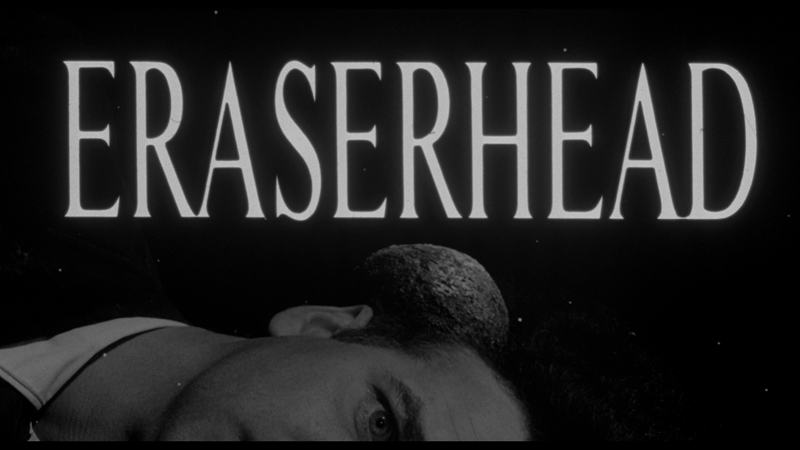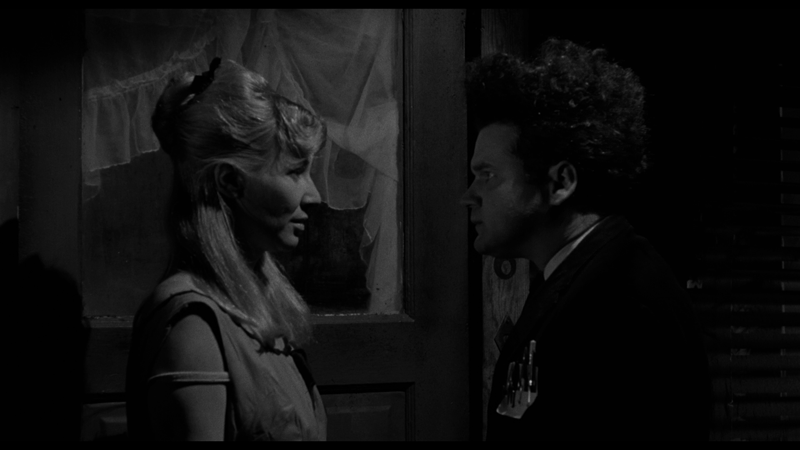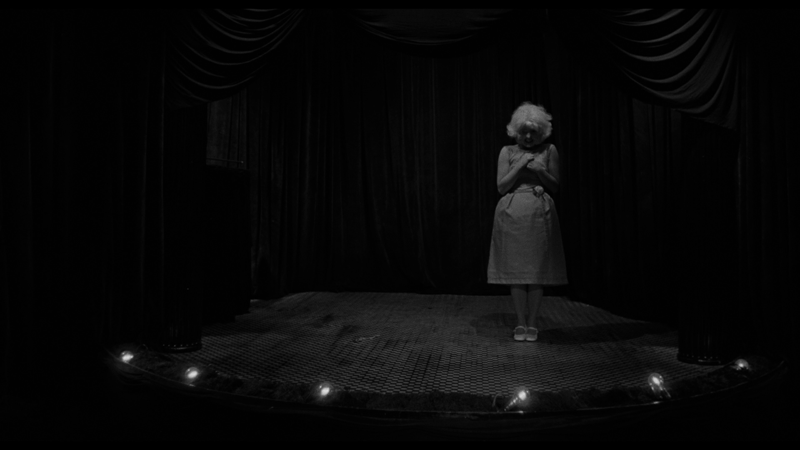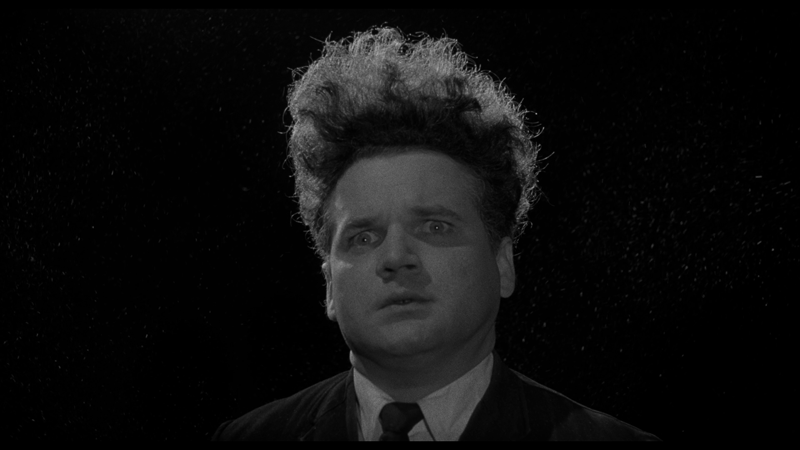| Reviews & Columns |
|
Reviews DVD TV on DVD Blu-ray 4K UHD International DVDs In Theaters Reviews by Studio Video Games Features Collector Series DVDs Easter Egg Database Interviews DVD Talk Radio Feature Articles Columns Anime Talk DVD Savant Horror DVDs The M.O.D. Squad Art House HD Talk Silent DVD
|
DVD Talk Forum |
|
|
| Resources |
|
DVD Price Search Customer Service #'s RCE Info Links |
|
Columns
|
|
|
Eraserhead
Let's get weird with David Lynch's feature debut

Loves: David Lynch, the Criterion Collection, cult movies
Likes: Freak-outs
Dislikes: Feeling uncomfortable
Hates: Gross-out horror
The Movie
It's surprising that Eraserhead is the first film by David Lynch to be entered into The Criterion Collection. A director of precise vision and distinct style, who has been behind the camera for a number of modern classics, including Blue Velvet, The Straight Story and Mulholland Drive, he seems like the perfect fit for this group of "important classic and contemporary films," but either way, he's finally in, and it has come with a film that represents all that Lynch is as a filmmaker and artist, a distillation of his creativity and peculiar imagination.
If you strip away all the oddness, Eraserhead offers up a very simple story about a man named Henry (Jack Nance) who finds himself unprepared when fatherhood surprisingly comes calling, causing confusion and dismay. This being a Lynch film though, that story is refracted through a dark prism, and that child is an inhuman monster, his confusion manifests itself in disturbing visuals like a disfigured woman performing in his radiator and no one, other than Henry, acts in a way that could be considered close to normal. Throw in a mysterious figure pulling levers and looking out a window in despair, and Henry's simple story becomes anything but.

Working in black and white, aided by cinematographer Fred Elmes, Lynch established himself here as a master of the odd image, whether it's the grotesque creatures that populate this world (which are highly impressive considering the era and budget), the stylish, detailed design of the sets or the iconic images throughout the movie. For fans of Lynch's later Twin Peaks, there are elements all over Eraserhead that later evolved into memorable parts of that series, including the black and white zig-zag of the floor of the Black Lodge. As Eraserhead is somewhat light on dialogue, it just proves Lynch's strength as a visual storyteller. No matter how surreal things get, and they get very surreal, you never feel like you've lost the thread (with the exception of the lever-puller, whose role is certainly open to interpretation.)
Though Lynch is primarily a visual artist (as seen in his non-cinematic output as well), one of the most striking elements of Eraserhead is the sound, marked by an ever-present layer of noise. If the otherworldly imagery didn't do the trick, the audio definitely establishes a sense of dread and general dis-ease, representing the presence of industry into Henry's human, organic world. At the same time, the film is loaded with what is best described as "wet" sounds that add discomfort to the viewing experience. However, of anything heard in the movie, nothing is as affecting or horrifying as the plaintive wail of Henry's child. For this alone, Lynch and his collaborator Alan Splet should receive some sort of sound achievement award, or perhaps some sort of punishment for crimes against humanity.

The Disc
Criterion has abandoned their dual-format releases, so Eraserhead arrives on one Blu-Ray, which comes in a moody black digipak folder, along with a hefty booklet, all of which is inside a starkly-designed slipcase. The simple, beautiful Criterion menu is paired with the film's eerie imagery to great effect and gives the choice to watch the film and check out the special features (remember, Lynch doesn't believe in chapter stops.) There are no audio options, but subtitles are available in English SDH. Once again, Criterion has provided all the extra material in both formats, which necessitated the second DVD.
The Quality
All you really need to know about this 1.85:1, 1080p, AVC-encoded presentation, via a new 4K transfer from the original negative, is that it was supervised by Lynch, so it must be right. A special calibration tool is even included to make sure you're watching the film the right way. The result is a beautifully haunting image that captures all of the film's creepy detail and turns back the effects of time with a crisp, flawless delivery, thanks to an extensive clean-up effort. With such an exceedingly dark picture, proper black levels are key, and this disc has them, along with a tremendous amount of fine detail (Lynch's horrific visions have never been so clear) and no visible issues with compression artifacts. This is the treatment Lynch deserved upon his entry to the Collection.
The audio is most likely the biggest element that makes Eraserhead such an engrossing experience, and the LPCM 2.0 track here, created in 1994 by Lynch and sound editor Alan R. Splet, received an additional polishing in 2014. The track now delivers an enveloping atmosphere that makes you constantly aware you are in Henry's world, and Henry's world is not well. There's such an attention to detail in the sound of this film, and this presentation brings it all to the fore in startling clarity and with terrifying depth. Listen to this track, and you will remember it forever. It will haunt your dreams.
The Extras
The bonus content kicks off with six short films by Lynch, giving a look at his early work, as well as an intriguing later experiment. Each film has an available video intro by Lynch (ranging from 1:14 to 5:11 in length), where he talks about the project and how it came together. First up is 1966's Six Men Getting Sick (4:02), which is probably the "artsiest" of Lynch's work on this disc, as it features a short loop of animation projected onto a sculpted screen, accompanied by a whining siren. Getting to see it over and over again allows you observe all the details and appreciate the hand-crafted quality of it (though, like the painting it essentially is, there's no story so to speak, except for one you create in your head.)
There's more animation, this time mixed in with live-action footage, in 1968's The Alphabet, a creepy blending of the classic A-B-C song, a ghoulish female and a good deal of blood. The main accomplishment here is the establishment of mood, but the use of sound will become a key in Lynch's work.
The Grandmother, from 1970, is the longest short here, at 33:48, and the most narrative, though there's next to no dialogue (and certainly nothing understandable spoken.) A blend of stylish black-and-white film and Terry Gilliam-esque animation, it's the story of a young boy, his abusive parents and the grandmother he creates to fill the void of love. It's very easy to see this film as a precursor to Eraserhead, as there are several themes and techniques in this grim film that Lynch would return to later.
1974's The Amputee might be the most interesting of the shorts, if only for its origins, and the fact that there are two versions of essentially the same film (one checking in at 5:11, the other at 4:05.) Existing only because Lynch's friend was asked to evaluate black and white video stock by the AFI, the movie is a very simple one-take film with no cuts, observing a double amputee (the Log Lady herself, Catherine Coulson) narrating a letter as a doctor (Lynch) takes care of her. It's fun to see what the difference is between the versions (once you figure it out) and it's interesting to see Lynch work on grainy video (a somewhat fitting medium.)
The last short film, 1995's Premonitions Following an Evil Dead, is very short, at just 1:03, but it's an interesting piece, as Lynch took part in an project involving a Lumiere camera, and had to shoot under something akin to Dogme 95 rules. That he was able to create what he did with the primitive tech and conditions is just a testament to his artistry. (The intro to this film also includes an adorable flub on the part of Lynch.
The remainder of the extras are presented in a distinctly Lynch-ian manner, with the menu simply offering a list of years, only explaining what you are watching once you select it. Things kick off in 1977, with the film's trailer, which offers a jarring assortment of imagery from the flm for just 46 seconds, holding back the most shocking moments for ticket buyers. If only all trailers were so effective and efficient.
Selecting 1979 brings an interesting archival interview with Lynch and Elmes at one of the film's locations (17:02), conducted by UCLA television student Tom Christie, for a class project. Now, certainly times have changed, but one could imagine what students in the class thought watching the awkward interview technique and shaky camera work, but there are some interesting thoughts shared (but just as many interesting details kept hidden.)
1982 is represented by a trailer created for the film's run as a midnight movie, featuring Lynch and four close friends (1:24.) This one is mainly valuable for the silly visual it's built around, a whim of Lynch's. It's followed by a 6:47 clip from the French show Cinema de notre temps (shot in 1988, but aired in 1993), following Lynch and Nance as they drive to one of the film's locations and chat about Californian food. Presented in English with French narration (and accompanied by appropriate French and English subtitles), it's a quirky little entry, but a nice addition for Lynch fans, who get to see some interplay between the director and his long-time collaborator.
1997 offers another archival interview and location visit, as Lynch, Nance, actress Charlotte Stewart and assistant director Catherine Coulson return to the AFI stables that served as the film's studio (a 16:23 clip from Toby Keeler's Pretty as a Picture: The Art of David Lynch.) The location is discussed and the experiences remembered, with the feel of a family reunion, as they joke and reminisce while wandering around the grounds.
2001 is the home of the biggest extra, the feature-length (1:25:08) documentary "Eraserhead" Stories, an oral history of the film directly from Lynch, in a simple head-on portrait shot, with Coulson throwing in some memories via telephone. There's something about Lynch just talking that is incredibly entertaining, especially when he's interacting with Coulson, often yelling to her. The way he says "Catherine" reminds so much of his Twin Peaks character that it elicits a smile every time. Unfortunately, by the time to reach this piece, you've heard a lot of the stories, but he's still fascinating to listen to, over an ever-present wind.
The final on-disc extra comes from 2014, in the form of new interviews with Coulson, Stewart and actress Judith Roberts and Elmes (26:12). Like the Lynch history, there's a good amount of overlap here, but there's also some fresh perspective, and you get a full view of the film's backstory and plenty of trivia regarding the lengthy, and oft-delayed production.
Once again, Criterion delivers a terrific booklet, this time running 68 pages, which includes an interview with Lynch from Chris Rodley's book Lynch on Lynch, illustrated with great behind-the-scenes photos from the set of Eraserhead. If you've watched all the extras, you'll notice quite a bit of repetition here, but there are a few items found only in the book, including talk of his favorite filmmakers and the secrets about the movie that he refuses to reveal.

The Bottom Line
Eraserhead is certainly not for everyone, but if you can deal with the surreal and especially the creepy, it offers an experience you definitely haven't had before: dark, funny, disturbing and moving. Fans of Lynch also get to enjoy seeing where it all began, as you can find hints of the greatness to come. Criterion has done one of their trademark reclamations here, making the film look and sound better than it ever has, while piling on the extras for fans of the film and of Lynch himself. If you can handle it, this is a must-own cult hit.
Francis Rizzo III is a native Long Islander, where he works in academia. In his spare time, he enjoys watching hockey, writing and spending time with his wife, daughter and puppy.Follow him on Twitter
*The Reviewer's Bias section is an attempt to help readers use the review to its best effect. By knowing where the reviewer's biases lie on the film's subject matter, one can read the review with the right mindset.
|
| Popular Reviews |
| Sponsored Links |
|
|
| Sponsored Links |
|
|
| Release List | Reviews | Shop | Newsletter | Forum | DVD Giveaways | Blu-Ray | Advertise |
|
Copyright 2024 DVDTalk.com All Rights Reserved. Legal Info, Privacy Policy, Terms of Use,
Manage Preferences,
Your Privacy Choices | |||||||














